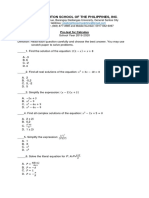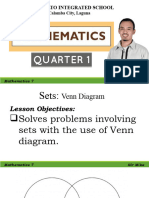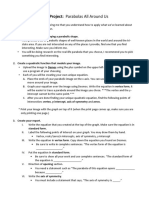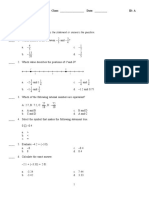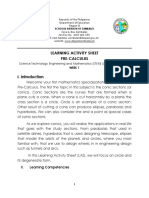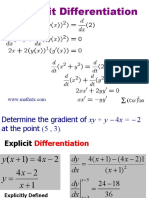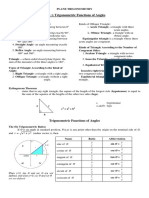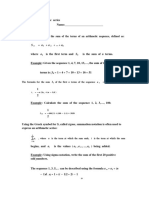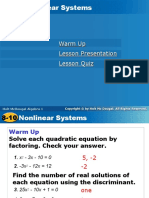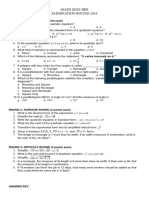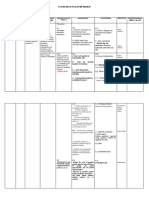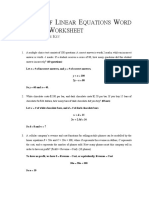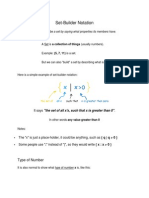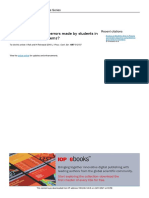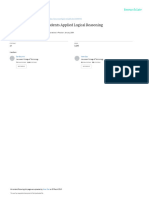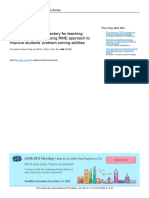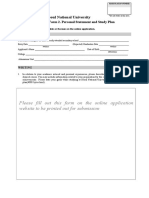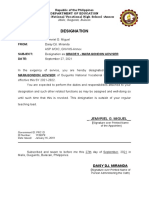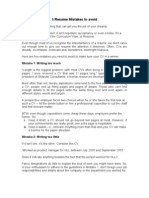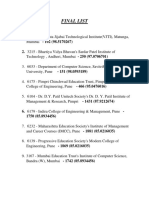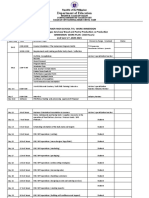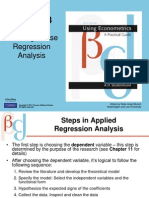Republic of the Philippines
Sta. Maria Campus
Sta. Maria, Pangasinan
Misconceptions and common errors in solving algebraic
equations: A study among Grade 7 students in
La Paz National High School
_______________________________________
A Thesis Presented to
The Faculty of the College of Teacher Education
Pangasinan State University
Sta. Maria, Pangasinan
In Partial Fulfillment of the Requirements for the Subject
Research 1
Geraldine C. Geron
Researcher
December 2023
1
� Chapter I
The Problem
Background of the Study
The study of algebra has long been considered a cornerstone of mathematics education,
yet many students struggle to understand and solve algebraic equations correctly (National
Council of Teachers of Mathematics, 2014). In recent years, there has been growing concern
about the gap between the number of students who are mathematically proficient and those who
are not (National Assessment of Educational Progress, 2019). One area where this gap is
particularly pronounced is in the ability to solve algebraic equations, which is a fundamental skill
required for success in higher-level math classes (Lester & Thorne, 2007). Despite its
importance, many students encounter difficulties when trying to solve algebraic equations, often
due to misconceptions or errors that can hinder their understanding of the subject matter (Hiebert
& Grouws, 2007).
The transition from arithmetic to algebra marks a significant shift in mathematical
thinking. Students are no longer dealing with concrete numbers but abstract variables
representing unknown quantities. This leap in abstraction often leads to a fundamental
misunderstanding of the equals sign. Many view it as a magical command to "do something" to
both sides, instead of recognizing its role as a neutral balance beam. This faulty interpretation
fuels a cascade of errors, such as adding or subtracting terms from only one side or treating the
equals sign as a cancel button.
Further complicating the equation are the ghosts of arithmetic habits. Students
accustomed to following a rigid order of operations struggle with the flexibility of algebra, where
order often matters less than understanding the underlying structure. This can lead to
2
�misapplication of PEMDAS (Parentheses, Exponents, Multiplication and Division, Addition and
Subtraction) or a blind adherence to specific steps regardless of the context.
Another lurking culprit is the concept of variables. For some students, variables remain
elusive, morphing into unknown numbers or even literal letters. This lack of grasp hinders their
ability to manipulate and transform expressions, making solving equations an uphill battle. The
fear of the unknown can also breed anxiety, further discouraging exploration and
experimentation with variables – crucial skills for algebraic fluency.
Finally, the symbolic nature of algebra can create a disconnect from the real world.
Students may struggle to translate word problems into algebraic expressions, failing to see the
connections between the abstract symbols and the concrete situations they represent. This lack of
grounding can render algebra a purely mechanical exercise, devoid of meaning and purpose.
Algebra, the language of patterns and relationships, unlocks a universe of problem-
solving power. Yet, for many Grade 7 students, it can feel more like a tangled jungle of
confusing symbols and cryptic rules. This study delves into the heart of this struggle, exploring
the persistent misconceptions and common errors that trip students up when solving algebraic
equations.
By investigating these prevalent misconceptions and errors, this study aims to illuminate
the hidden obstacles that hinder Grade 7 students' journey into the world of algebraic equations.
By understanding these challenges, the researcher can design more effective teaching strategies,
bridge the gap between symbols and reality, and empower students to confidently navigate the
intricate but rewarding jungle of algebra.
Misconceptions refer to incorrect beliefs or ideas that students hold about mathematical
concepts, while common errors are specific mistakes that students make when solving problems
3
�(Tucker & Henk, 2018). In the case of algebraic equations, these misconceptions and errors can
arise from various sources, including poor instruction, lack of practice, or insufficient
reinforcement of key concepts (Knuth & Frank, 2017). The researcher's study aims to identify
some common misconceptions and errors that Grade 7 students in La Paz National High School
encounter when solving algebraic equations. By analyzing data, the researcher hoped to uncover
patterns and trends in how these misconceptions and errors emerge and what factors contribute to
them. The researcher also sought to determine whether addressing these misconceptions and
errors could improve student learning outcomes and increase confidence in math classes.
One of the most frequent errors was the failure to isolate variables on one side of the
equation, leading to confusion between like terms and unlike terms. Other common errors
included neglecting to use parentheses or brackets to indicate order of operations, confusing the
meaning of variables, and misunderstanding the concept of inverse operations. These errors often
resulted in incorrect solutions or difficulties in solving more complex problems.
The researcher findings suggest that a combination of these factors can contribute to the
development of misconceptions and errors in solving algebraic equations. For example, students
who had limited exposure to algebraic concepts at an early age were more likely to struggle with
these skills later (Lester & Thorne, 2007). Similarly, poor instructional methods, such as relying
too heavily on memorization rather than problem-solving strategies, can hinder student learning
(Hiebert & Grouws, 2007). Addressing these underlying factors is crucial to preventing
misconceptions and common errors in algebra education. By incorporating more interactive and
engaging instructional strategies into their lessons, teachers can help students build a deeper
understanding of algebraic concepts and develop stronger problem-solving skills. Additionally,
4
�providing regular opportunities for practice and reinforcing key concepts through real-world
examples can help students overcome any misconceptions or errors they may encounter.
Statement of the Problem:
This study aims to identify these misconceptions and common errors to inform teaching
practices and improve student learning outcomes.
Specifically, it aimed to answer the following questions:
1. What is the profile of respondents in terms of:
a. Age:
b. Gender:
2. What are the most common misconceptions and common errors observed among Grade 7
students when solving algebraic equations?
3. Is there a significant difference in the misconceptions and common errors observed
across the respondent’s profile?
Hypothesis of the Study
This study will be anchored on the following hypothesis. It will be tested in its null form
at 0.05 level of significance.
1. There is a significant difference in the misconceptions and common errors
observed across the respondent’s profile.
Scope and Delimitation
The main purpose of the study is to determine the misconceptions and common errors in
solving algebraic equations among Grade 7 students. This study will be conducted at La Paz
5
�National High School for the current year. The scope of this study does not include all junior
high school students in Umingan, Pangasinan. Forty students from Grade 7 students will take
part as respondents.
Significance of Study
The following entities was benefit from this research study:
Teachers: This research will provide the teachers with information for a re - evaluation of math
lessons that can help the grade 7 students to adjust their academic needs.
Students: This can help them to assess and maintain their very own academic performance. To
assist themselves and implement the improvement of their mathematical skills.
School Administrators: The findings of this study will provide them with insight into various
lesson adjustments that can assist the students to reach the amount of mathematical skill level.
Administrators may devise a solution to guide the students to improve their mathematical skills.
Future researchers. The future researchers can use this study as their reference on their own
research as it gives information about how students can study efficiently.
Definition of Terms
Misconceptions: In this study, misconceptions refer to the incorrect or incomplete
understandings that students hold about algebraic equations, which may hinder their ability to
solve them correctly. These misconceptions may arise from various sources, including prior
knowledge, cognitive development, and instructional strategies.
Common errors: Common errors are mistakes that students frequently make when solving
algebraic equations, such as misunderstanding the symbols, formulas, or steps involved in the
problem-solving process. These errors may be related to the misconceptions identified above.
6
�Algebraic equations: Refers to the mathematical expressions involving variables, constants, and
operations (e.g., addition, subtraction, multiplication, division) that must be solved using logical
reasoning and problem-solving skills.
Problem-solving strategies: Refers to the approaches or techniques used by students to solve
algebraic equations, such as direct manipulation, pattern recognition, or guess-and-check
methods.
Student learning outcomes: Refers to the desired achievements or competencies that students
should demonstrate after being taught algebraic equations, such as the ability to solve simple
linear equations, interpret graphs, or apply algebraic concepts to real-world problems.
Instructional strategies: Refers to the teaching methods or approaches used by teachers to
deliver mathematics education, including traditional lectures, hands-on activities, technology
integration, or project-based learning.
Cognitive development: Refers to the mental processes and abilities that enable individuals to
acquire knowledge, reason, and solve problems. In this study, cognitive development will be
used to explain how students' understanding of algebraic equations evolves over time.
Prior knowledge: Refers to the existing knowledge and experiences that students bring to the
classroom when learning new concepts, including their understanding of basic arithmetic
operations, geometry, or other mathematical topics.
Cultural norms and values: Refers to the shared beliefs, attitudes, and practices within a
particular cultural context that influence how students perceive and interact with mathematical
concepts, including algebraic equations.
Peer interaction: Refers to the social interactions between students during math lessons, which
can affect their learning outcomes, particularly in algebra. Positive peer interaction can promote
7
�collaboration, sharing of ideas, and mutual support, while negative peer interaction can lead to
confusion, misconceptions, or errors.
Chapter II
REVIEW OF RELATED LITERATURE AND STUDIES
The study of misconceptions and common errors in solving algebraic equations is an
important area of research in mathematics education. Research has shown that many students
struggle with these concepts, often due to prior knowledge, cognitive development, and
instructional strategies (Cognition, 1985; Hiebert & Grouws, 2007).
Studies have identified several common misconceptions and errors among grade 7
students when solving algebraic equations, including:
Confusion between like terms: Many students confuse terms that have different
coefficients but the same variable(s) (Knuth & Kafkas, 2013).
Over-reliance on memorization: Some students rely too heavily on memorizing formulas
and procedures without developing a deeper understanding of the underlying mathematical
concepts (Lave & Wenger, 1991).
Difficulty interpreting graphs: Students may struggle to interpret and analyze graphical
representations of algebraic functions, leading to errors in their solutions (Stewart,
2007).
The literature suggests that addressing misconceptions and common errors in solving
algebraic equations requires a comprehensive approach that incorporates both instructional
design and teacher professional development. Hiebert and Grouws (2007) recommend using
8
�concrete manipulatives and visual aids to help students build a deeper understanding of algebraic
concepts, while Lave and Wenger (1991) emphasize the importance of social learning and
collaboration in mathematics education.
Lack of problem-solving skills: Many students lack the ability to apply algebraic
concepts to real-world problems or to develop their own problem-solving strategies (Hiebert &
Grouws, 2007).
Researchers have used various methods to investigate these misconceptions and errors,
including surveys, interviews, and observational studies. For example, Knuth and Kafkas (2013)
conducted a survey of high school students to identify their most frequent mistakes when solving
linear equations, while Stewart (2007) observed and analyzed the problem-solving strategies of
college students when solving algebraic equations.
Conceptual Framework:
Algebraic equations are a fundamental aspect of mathematics education, as they help
students develop problem-solving skills and logical reasoning abilities.
Despite their importance, many students encounter difficulties when solving algebraic
equations, often due to misconceptions or common errors. These misconceptions can be
influenced by various factors, such as prior knowledge, cognitive development, and instructional
strategies.
Independent Variable Dependent Variable
Profile of the respondents in terms of: Is there a significant difference in the
misconceptions and common errors
a. Age:
b. Gender observed across the respondent’s profile
9
� Figure 1. Conceptual Paradigm of the Study
The study aims to determine the Misconceptions and common errors in solving algebraic
equations among Grade 7 students in La Paz National High School. Figure 1 shows the
independent and dependent variable of the study entitled the Misconceptions and common errors
in solving algebraic equations: A study among Grade 7 students in La Paz National High School
where the independent variables are the respondent’s profile, and the dependent variables are the
significant difference in the misconceptions and common errors observed across the respondent’s
profile.
10
� CHAPTER III
RESEARCH METHODOLOGY
This chapter presents the research method or design to be used, the respondents, the
instrument, administration of instruments, and the procedures of data analysis.
Research Design
The type of research used was quantitative research. Quantitative Research is a type of
research that uses numerical data rather than words. The quantitative method is the best fit for
this research for it uses mathematical and statistical methods in collecting and gathering
information. (Jackson 2009). The research uses a descriptive survey method in relation to their
objective of discovering the misconceptions and common errors in solving algebraic equations
among Grade 7 students at La Paz National High School.
Additionally, according to Dr. Y.P Aggarwal (2008) descriptive research is devoted to
the gathering of information about prevailing conditions or situations for the purpose of
description and interpretation. In survey method research, participants answer questions
administered through interviews or questionnaires. This method will bring more accurate data for
the researchers.
Locale of the Study
This study will be conducted at La Paz National High School for S.Y. 2023-2024. This is
located at Neighborhood St. Brgy. La Paz, Umingan, Pangasinan. This school comprises Junior
High School and Senior High School that offers two strands which are Humanities and Social
11
�Sciences (HUMSS), and General Academic Strand (GAS) and one track which is Technical-
Vocational-Livelihood (TVL) Track.
Respondents of the Study
The respondents of the study are Grade 7 students at La Paz National High School with a
total of 40 respondents.
Sampling Scheme
The study will utilize availability and purposive sampling methods. Availability sampling
is a method where the participants show their willingness to respond to the questions.
Meanwhile, the purposive sampling method is a non-probability sampling method in which
researchers rely on their own judgment when choosing members of the population to participate
in their surveys. In this instance, the researcher was able to obtain another, more carefully chosen
random sample that is eager to take part in the study.
Data Collection Procedure
The researchers seek first for the request of approval in the conduct of this research. The
researcher gets the request letter once it has been approved. The principal, as well as class
advisers and other faculty members, were selected by the administration. In administering the
questionnaire, the researcher used the time allotted for it to avoid distractions from class
discussions. Enough time was given for the student responses to address the questions. After data
gathering, the researcher now collected it for tallying the scores and applying the statistical
treatment to be employed with the study.
Data Gathering Instrument
12
� The method of collecting data that the researcher used was researcher-made tests and
measurements to gather the needed data for the Grade 7 students' knowledge.
In the preparation of the instrument, the requirements for designing a good data collection
instrument were considered. For instance, tests were toned down to accommodate the stock
knowledge preparedness of the Grade 7 students. Researchers provided a test activity used to
accumulate data on a person's ability to perform the test.
Statistical Treatment of Data
Frequency and percentage will be used to describe the profile of the respondents. The
standard deviation will be obtained to describe the homogeneity of the response of the
respondents. A percentage frequency distribution is a display of data that specifies the percentage
of observations that exist for each data point or grouping of data points. The Formula for you to
get the percentage frequency distribution is:
P= F x 100 / N
Where:
P= percentage
F= frequency
N= total number or respondents
The T - Test was also utilized to define and calculate the sum of the differences of each
pair divided by the square root of n times the sum of the differences squared minus the sum of
the squared differences, overall n-1. Where, Ed is the sum of the differences.
The T Test will be used to determine the significant differences of their misconceptions
and common errors observed of Grade 7 students across their profiles. T-TEST determines
13
�whether there is any significant difference between the two groups.
Whereas:
X1 is the mean of 1st group
X2 is the mean of 2nd group
S1 is the variance of the 1st group
S2 is the variance of the 2nd group
N1 is the total number of respondents of the first group
N2 is the total number of respondents of the second group
References:
14

